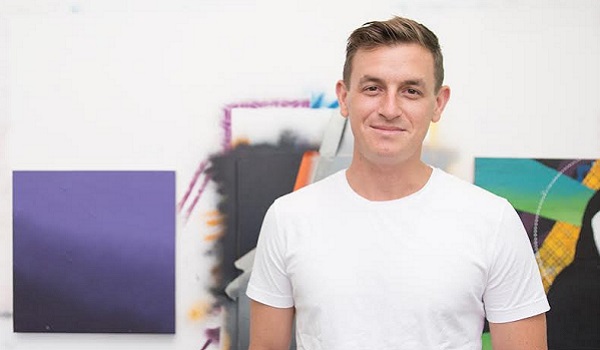Image: Strider Patton, in his studio, San Francisco.
Strider Patton works at the intersections of street art, public space, culture, community representation, history, urban politics, democracy, and artistic social pedagogy to explore how art can contribute to changing perspectives, and in turn the world. With a practice centred on social awareness and compassion, the San-Francisco-based artist has spent over a decade creating site-specific interventions manifested as murals, installations and community projects. Mindful of differences and complexities of the human condition, Strider wants to help answer the BIG question in life: who are we, why are we here, and where are we going?
For his current show at The Smallest Gallery in Soho, (K)now shows a room divided. One side sterile white, the other side, a blast of colour, shapes, patterns and energy. Patton’s purpose of this installation is to give the observer a moment of pause to contemplate that “the other” is not so different from themselves, and in doing so, he hopes this work may offer the gift of remembering our shared humanity.
We asked Strider a few questions about his new installation (K)now, working in the public realm across different disciplines and connecting with communities through education.
Jareh Das: Your approach to art-making crosses different disciplines – art, anthropology and pedagogy. How important do you feel it is for art to look to other disciplines so it can draw in different audiences?
Strider Patton: I believe that other disciplines can not only offer great inspiration for new art but also invite new audiences in. For me, it is very important for art to speak to the current time and people; to make new connections, to share thoughts, ideas, reflections and dreams. I love public art because it invites a greater audience in for these experiences, free of charge. Art pushes culture and in turn the world, so for me, art has a powerful way to bring us together, from different communities, and move forward together.
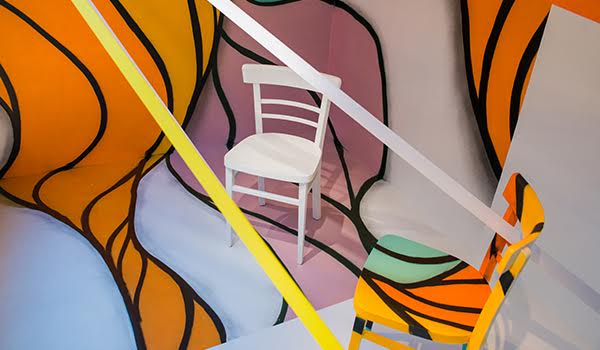
Image: Detail of ‘(K)now’ by Strider Patton at The Smallest Gallery in Soho. Photograph by Opal Turner.
Jareh: How did you arrive at mural making and are there particular muralist works that inspired you to take up this art form?
Strider: There were many street and mural artists that inspired me in the early 2000s when I first began paying attention and then creating my own work. My first inspirations were Swoon, BLU, Os Gemeos, Shepard Fairey, Herakut and Miss Vann to name a few. I was enamored with art outdoors and in often nontraditional spaces. My dad was a large-scale steel sculptor so I grew up seeing what public art could do to transform a space. He taught me how to use my hands, how to see art, think and create work. But the DIY, direct action of local street art was something exciting and different in my early days.
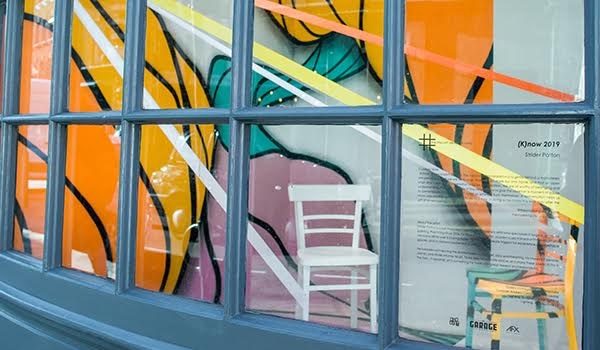
Image: Detail of ‘(K)now’ by Strider Patton at The Smallest Gallery in Soho. Photograph by Opal Turner.
Jareh: Your art, teaching, and collaborations have at their core connecting and tapping into human emotion. As we live in an ever evolving and detached-from-emotion existence, how do you see art counteracting this move away from emotions?
Strider: I once read a quote by Roy Ascott by way of Brian Eno, “Stop thinking about art works as objects, and start thinking about them as triggers for experiences.” I think about this often. We live in a fast paced, material driven, sensory overloaded world and our emotions are being numbed or even dumbed down from this. Art, in its many forms, has the ability to trigger emotions in us. However, the art has to be right. Of course, art is subjective, but I believe that handmade, intentional art has a kind of value intrinsically attached to it that you just don’t get when purchasing a mass-produced poster or canvas from Ikea. Sure this art may cost more, but what are you purchasing? A thing, or an emotion?
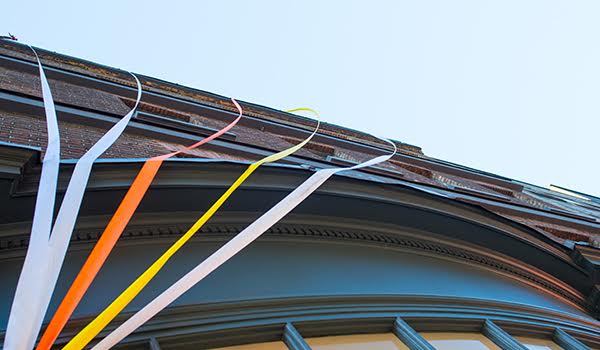
Image: Detail of ‘(K)now’ by Strider Patton at The Smallest Gallery in Soho. Photograph by Opal Turner.
Jareh: Tell us a bit about how you conceptualised your new installation (K)now at The Smallest Gallery in Soho, London?
Strider: Central to a lot of my work over the last few years has been concepts of connection and division, of history and future. Observing recent events taking place around the world I knew that I wanted to create an installation that brings these concepts together, and in a different way than I had ever before. I’ve painted many murals. I’ve installed with ribbon just a few times. I’ve never incorporated furniture. Working with Andreia Costa and Philip Levine, Co-Curators of The Smallest Gallery in Soho, we wanted to try and push the boundaries of the space and bridge the divide between the indoor space and the outdoor street. The room, divided in two symbolizes our notions of ‘us’ and ‘them’. The empty chairs symbolize that a conversation focused on commonalities instead of differences may be our salvation (though this is no easy task). And the ribbons symbolize the threads that make up our social fabric. Especially in cities, we are all woven in together.
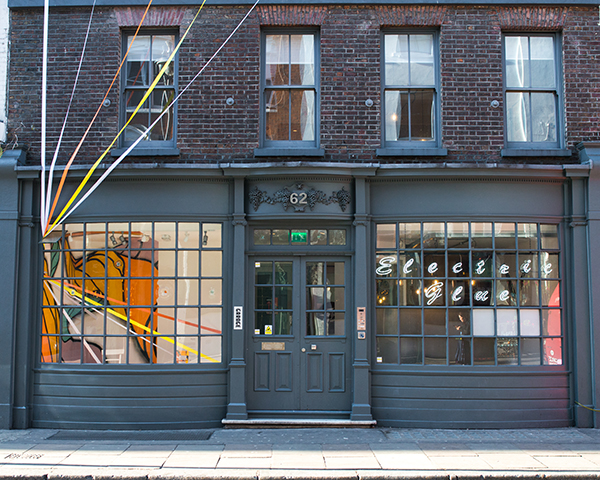
Image: Detail of ‘(K)now’ by Strider Patton at The Smallest Gallery in Soho. Photograph by Opal Turner.
Jareh: (K)now as an artwork grounded in finding commonalities speaks to timely and important questions about borders – who’s in, who’s out and so on. Given the context of showing this installation in the UK at the height of Brexit, what do you hope visitors take away from their experience of this work?
Strider: I hope that visitors may take a moment of pause to think of what may come from a conversation with a person who they do not know or have concern over. My schooling in cultural anthropology has given me a tool set for being aware of my own implicit biases, how to step back from my own culture and how to see another with empathy and dignity. I hope that this work may remind visitors that meeting the other is important for the benefit of all. Brexit is a complex situation (we have our own in the USA too), and I do not mean to speak on any high authority, but in our highly globalized world, with all the major problems we are beginning to face, I believe that cooperation will be our hope.
Jareh: How do you see art changing the world we live in now, and in the future?
Strider: We have been making art since our beginning. We are the maker ape. Art and creativity and cooperation have led to everything that we have built/made in the world today. We are behavioural, social, thinking, feeling animals. Our brains are running 2-million-year-old hardware (wired for fight/flight/food/f**k) in a techno-globalized 21st century world and we’re seeing some conflict. I hope that art may be our guiding path through this. If we can grow from 150-person hunter/gatherer tribes to 300 million-person nations, caring about those far away that we will never meet, then I hope that we can now expand that number to the global population of 8 billion. If anything can bring us together and recognize our shared humanity, it’s art.
Strider Patton
Strider Patton | @stridetheory | Instagram | Facebook
Strider Patton: ’(K)now’
Now until 30 April 2019
The Smallest Gallery in Soho
62 Dean Street, London W1D 4QF
thesmallestgalleryinsoho.com
instagram.com/thesmallestgalleryinsoho
@smallgallsoho
‘(K)now’ is curated by Philip Levine and Andreia Costa.
About the Curators:
Philip Levine
Philip has been working in the creative and cultural industries for the last decade as a producer. This has ranged from exhibitions, events, publishing, talks and creating his own unique artwork under the title ‘Headism’. He has gained a MA in Culture, Policy and Management at City, University of London. Being from London, his passion is knowing ‘who and what’ is up and coming in cultural trends and being involved within them.
Andreia Costa
Andreia is an Associate Architect at Jamie Fobert Architects. She studied in the Faculty of Architecture at the University of Porto and practiced for 3 years in her native Portugal. Before moving to the UK Andreia decided to explore her contemporary art interest by working in Serralves Museum of Contemporary Art as an architecture and art lecturer. In 2010 she joined Jamie Fobert Architects, where she has been involved in several projects including Selfridges and Tate exhibitions.
About the Gallery Manager:
Moira Rizopoulos
Moira is a Creative Producer at The Garage Soho, she works on array of creative projects, including advertising campaigns, films, exhibitions and events. It was this role that lead her to manage ‘The Smallest Gallery in Soho’ where she helps showcase creative and thought-provoking work. Previously, Moira gained a BA in Fine Art and a MA in Arts Administration and Cultural Policy from Goldsmiths, University of London.
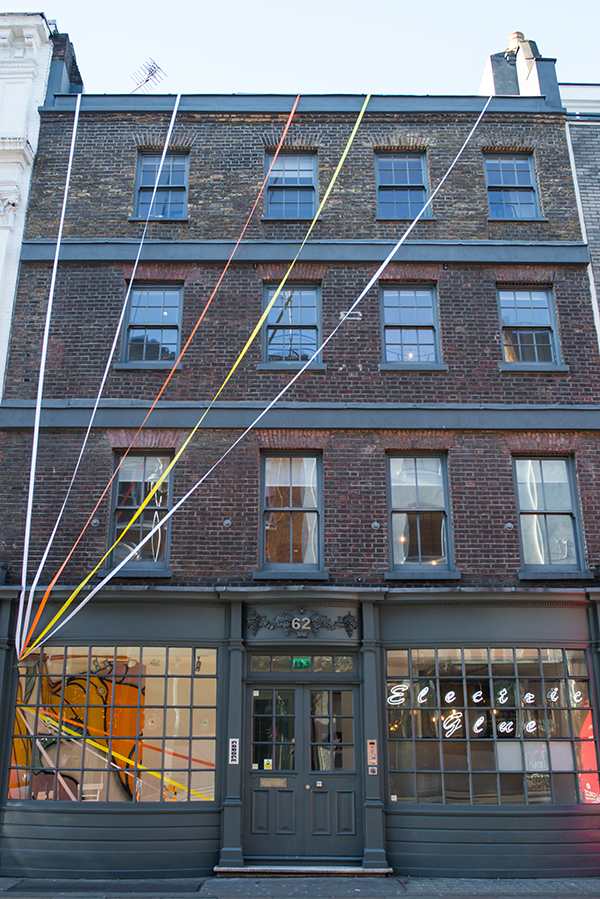
Image: ‘(K)now’ by Strider Patton at The Smallest Gallery in Soho. Photograph by Opal Turner.
